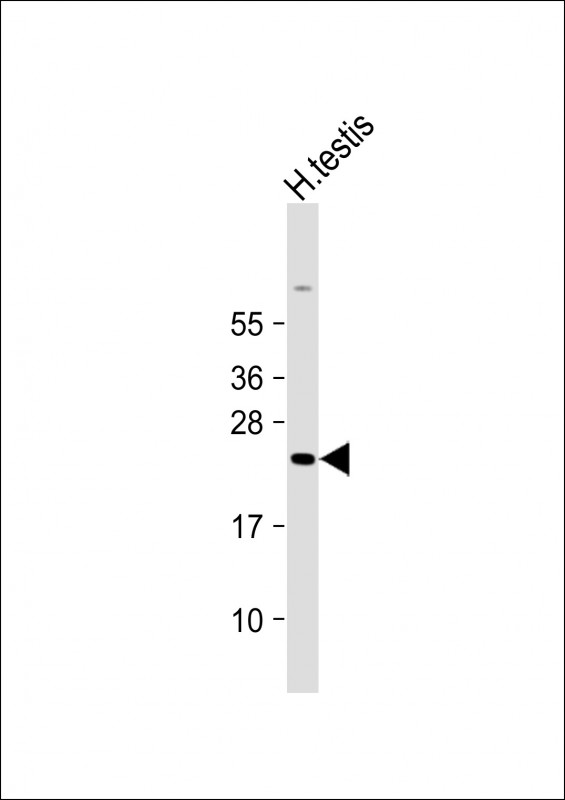
| WB | 1/1000 | Human,Mouse,Rat |
| IF | 咨询技术 | Human,Mouse,Rat |
| IHC | 咨询技术 | Human,Mouse,Rat |
| ICC | 技术咨询 | Human,Mouse,Rat |
| FCM | 咨询技术 | Human,Mouse,Rat |
| Elisa | 咨询技术 | Human,Mouse,Rat |
| Aliases | Histone H2B type W-T, H2B histone family member W testis-specific, H2BFWT |
| Entrez GeneID | 158983 |
| WB Predicted band size | 19.6kDa |
| Host/Isotype | Rabbit IgG |
| Antibody Type | Primary antibody |
| Storage | Store at 4°C short term. Aliquot and store at -20°C long term. Avoid freeze/thaw cycles. |
| Species Reactivity | Human |
| Immunogen | This H2BFWT antibody is generated from rabbits immunized with a KLH conjugated synthetic peptide between 62-88 amino acids from the Central region of human H2BFWT. |
| Formulation | Purified antibody in PBS with 0.05% sodium azide. |
+ +
以下是关于H2BFWT抗体的3篇代表性文献,按研究内容和应用方向概括:
---
1. **文献名称**:*H2BFWT is a novel human testis-specific histone modification associated with chromatin remodelling*
**作者**:Churikov D. et al. (2014)
**摘要**:该研究首次报道H2BFWT作为睾丸特异性组蛋白变体,在精子发生中参与染色质重塑。作者通过特异性抗体检测发现H2BFWT在减数分裂后精细胞中高表达,并验证了抗体在免疫荧光(IF)和Western blot(WB)中的特异性。
2. **文献名称**:*Aberrant expression of histone H2B subtypes in hepatocellular carcinoma*
**作者**:Li Y. et al. (2019)
**摘要**:研究利用H2BFWT抗体分析肝癌组织中组蛋白变体表达谱,发现H2BFWT在癌旁组织低表达,但在肿瘤组织中异常上调,提示其可能作为肝癌诊断标志物,并验证了抗体在免疫组化(IHC)中的应用可靠性。
3. **文献名称**:*Development of a monoclonal antibody specific to H2BFWT for human germ cell studies*
**作者**:Tanaka H. et al. (2016)
**摘要**:本文描述了针对H2BFWT的单克隆抗体制备及验证,通过ELISA、WB和质谱确认抗体特异性,并应用于人类睾丸组织切片,证明其在生殖细胞发育阶段的动态表达模式。
---
**备注**:若需获取具体文献,建议通过PubMed或SciHub输入标题/作者查询全文。部分研究可能涉及H2BFWT的功能机制或疾病关联,可根据实际研究领域进一步筛选。
The H2BFWT antibody targets the histone H2B family member W testis-expressed (H2BFWT), a variant of histone H2B predominantly expressed in the testis, particularly during spermatogenesis. Histones are core components of nucleosomes, essential for chromatin structure and gene regulation. Unlike canonical histones, H2BFWT is encoded by a single-copy gene on the X chromosome (Xq22.1) and is implicated in chromatin remodeling during sperm development. Its expression is tightly regulated, with roles in sperm chromatin compaction, possibly replacing somatic histones during spermiogenesis to facilitate transcriptional silencing and DNA condensation.
H2BFWT antibodies are critical tools for studying germ cell development, infertility, and testicular cancers. Research suggests H2BFWT overexpression in some cancers, including testicular germ cell tumors, highlighting its potential as a biomarker. The antibody aids in detecting H2BFWT in immunoassays (e.g., Western blot, immunohistochemistry) to explore its spatial-temporal expression and functional interactions. Challenges include ensuring specificity due to high homology among H2B variants. Recent studies also link H2BFWT to non-gonadal roles, such as neuronal development, expanding its biomedical relevance. Understanding H2BFWT's dynamics enhances insights into epigenetic regulation, reproductive biology, and oncogenesis.
×